Today’s world is hyper-connected. Businesses have an unprecedented chance to reach audiences across borders. They can promote products or services globally. The key to success in global digital marketing is adapting. You must adapt your strategies to fit many cultures. They have different languages and online behaviors.
International digital marketing involves optimizing your website, content, ads, and online presence. It’s to reach and engage audiences in specific countries or regions. This requires localizing your marketing efforts. You must cater to local languages, search engines, cultural norms, and customer preferences.

Imagine you’re planning a trip to a foreign country. You don’t speak the language or understand the customs. You’d likely struggle to navigate and miss out on many amazing experiences. The same goes for global digital marketing. If you don’t localize your approach, your brand’s message and offerings could get lost. This would stop you from fully connecting with your desired global audience.
How can you craft a good global digital marketing strategy? It needs to resonate across borders. Let’s dive into the key elements you should focus on.
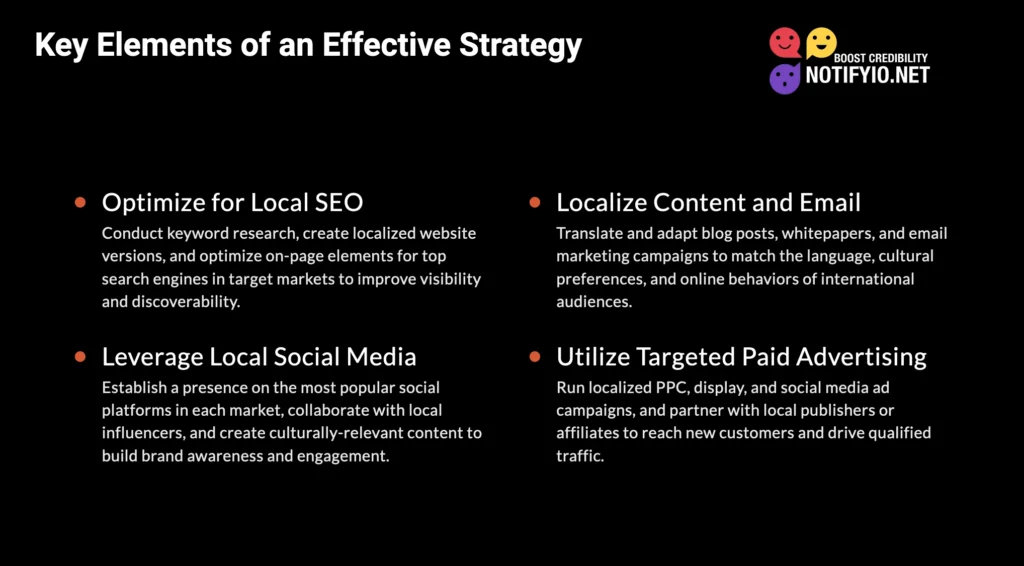
Key Takeaways
🌐 Going global with your digital marketing requires a strategic and localized approach tailored to each target market.
📈 Effective international digital marketing involves optimizing your website, content, and campaigns for local search engines, languages, and cultural norms.
💻 Leverage local influencers, social media platforms, and paid advertising channels to increase brand visibility and reach new audiences worldwide.
👥 Continuous market research, testing, and analytics are crucial to refine your international digital marketing strategies for long-term success.
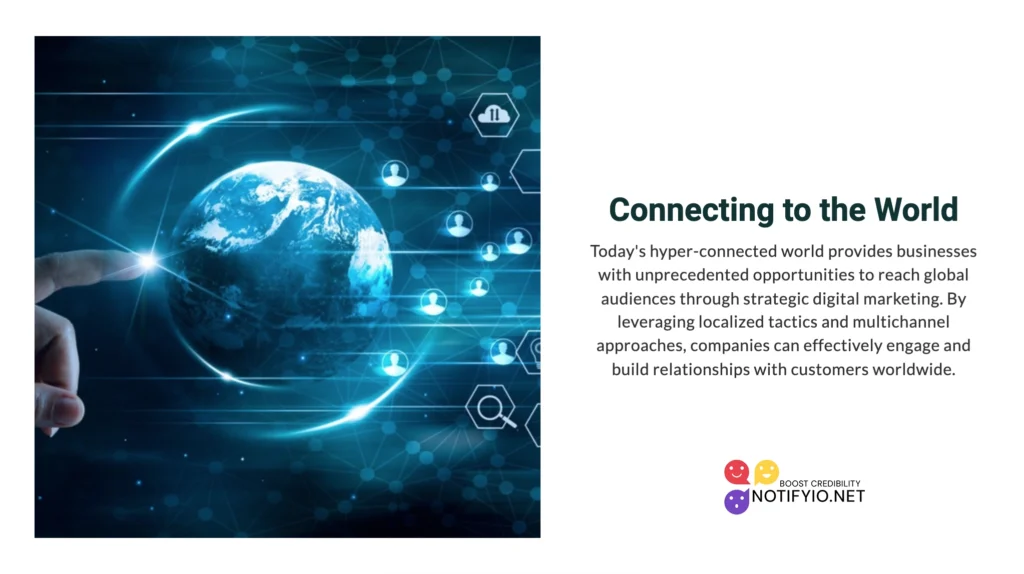
Optimize Your Website for International SEO
Your website is often the first contact for potential international customers. So, it’s crucial to ensure it’s optimized for local search engines and user experiences. Here are some tips:
- Do thorough keyword research for each target market. Consider the language and culture of searchers.
- Create local website versions or subdomains. They should have translated content, local currency, and contact information, as well as culturally relevant imagery.
- Improve meta tags, URLs, and other on-page elements for local keywords and search engines. For example, Baidu in China and Yandex in Russia.
- Make sure it loads fast and works on mobile. Many international users rely on mobile for internet.
Make your website locally relevant. Make it easy to find through search. Doing this will help you attract and keep international audiences.
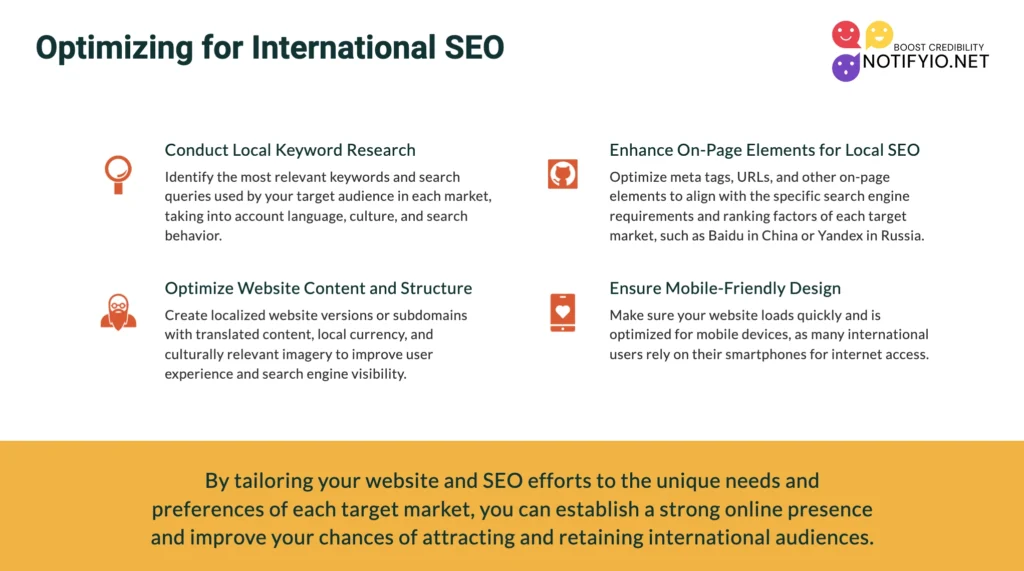
Leverage Local Social Media and Influencer Marketing
Platforms like Facebook, Instagram, and TikTok have become powerful. They are tools for reaching global audiences. However, usage patterns and popular platforms can vary significantly across regions. Here’s how to leverage social media effectively:
- Research the most popular social networks in your target markets. Then, make accounts tailored to each platform’s norms and preferences.
- Partner with local influencers who connect with your target audience. They’ll authentically promote your products or services.
- Make content for each market on social media (videos, images, stories). It should match the local culture and language.
- Join relevant online communities and discussions. This will help you build relationships and credibility with potential customers.
You can increase brand awareness by using social media and influencer marketing. They also help you build trust and engage with your international audiences.
Implement Localized Content and Email Marketing
Content is king in digital marketing. But, it must be tailored to your target markets to work well. Here are some strategies to localize your content and email marketing efforts:
- Translate and adapt your blog posts, whitepapers, and other content for other languages and cultures. Ensure the messaging resonates with local audiences.
- Use local writers or translators. They understand the nuances of each market’s language and culture.
- Make email marketing campaigns for specific places. Tailor the messages, subject lines, and calls-to-action for each audience.
- Segment your email lists by location and language. This way, you can send each subscriber content that is personalized and relevant.

You can nurture relationships with global audiences. You can do this by offering valuable, local content and email campaigns. These actions can also help you become a thought leader and boost sales.
Utilize Paid Advertising Across Multiple Channels
Organic search and content marketing are essential. But, adding strategic paid ads can speed up your global reach and visibility. Here are some tactics to consider:
- Run localized pay-per-click (PPC) and Google Ads campaigns. They should target specific countries, languages, and relevant keywords.
- Advertise on popular local platforms and apps. For example, WeChat in China and Line in Japan. Your target audience spends time on these sites.
- Partner with affiliate marketers or publishers in your target markets. They will help you promote your products or services to their engaged audiences.
- Try different ad formats like text, video, display, and social media. Optimize them based on performance data.
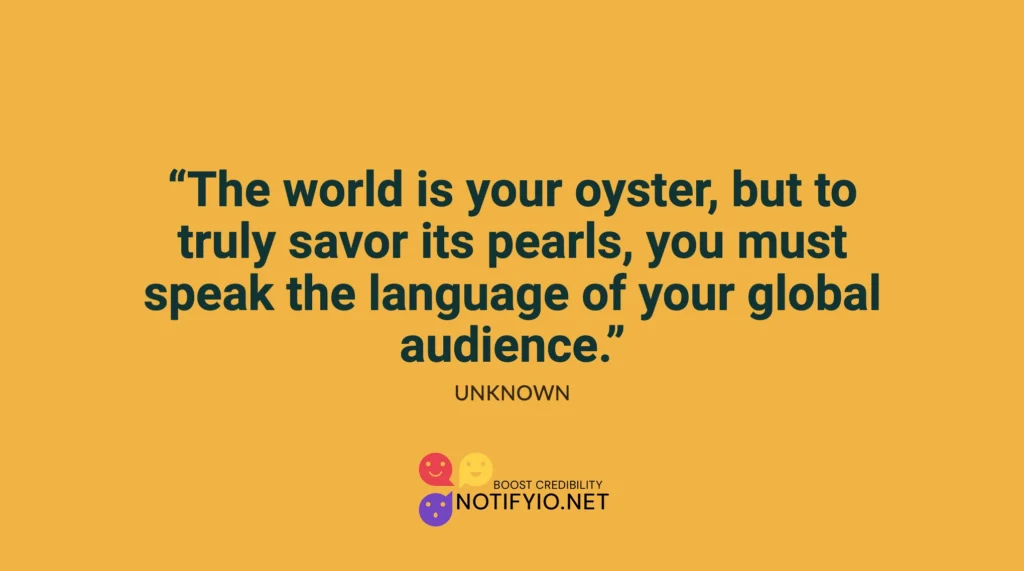
Diversify your ads and tailor them to local tastes. This can drive targeted traffic, and boost brand awareness and leads from global markets.
Continuously Monitor, Analyze, and Refine
It is an ongoing process. It needs constant monitoring, analysis, and improvement. Here are some best practices to follow:
- Use strong analytics and tracking tools. They will measure how well your website, campaigns, and marketing channels perform in different markets.
- Regularly review and analyze key metrics. These include website traffic, conversion rates, engagement, and revenue by location.
- Do A/B testing and UX analysis. They reveal areas for improvement. Use them to optimize your strategies with real user data.
- Stay updated on local market trends. Also, watch consumer behaviors and industry developments. They might impact your global digital marketing efforts.
- Keep improving your strategies. Do this based on data insights and feedback from local teams or partners.
By using data and being agile, you can continuously improve your global digital marketing strategies. You can find areas to improve and stay ahead of local competition.
Frequently Asked Questions
- Why is international digital marketing important? It lets businesses expand their reach. They can tap into new markets and sell to a global audience. Companies can engage with and build trust among international customers. They can do this by tailoring strategies to local preferences and norms.
- What are the biggest challenges in international digital marketing? Key challenges include language barriers, differing cultural norms, and preferences. Also, there are differences in online behavior and platform usage. And, there is navigating local regulations and legal needs. Overcoming these obstacles requires thorough market research, localization efforts, and continuous adaptation.
- How do I choose the right target markets for international expansion? When picking target markets, consider their size and growth. Also, think about competition, market entry difficulty, and cultural and language similarities. Lastly, consider how they fit your business goals and resources. Conducting thorough market research and analysis is crucial.
- Should I create separate websites or subdomains for each target market? The decision depends on many factors. These include the needed level of localization, technical issues, and resources. Separate websites or subdomains can give a local experience. But, they may need more maintenance. Or, a single website can be cheaper for some businesses. It has local content and language options.
- How can I measure the success of my international digital marketing efforts? Track these KPIs. They include: website traffic, engagement metrics (time on site and bounce rates), conversion rates, lead generation, sales figures, and return on investment (ROI). Also, track them by location. Continuously monitor and analyze these metrics. They can help you refine your strategies for the best results.
- How important is local market research in international digital marketing? Researching local markets is crucial. It helps us understand the quirks of each culture. It also shows us what consumers there like and the local language. This insight can inform everything. It affects messaging, content, ad channels, and platform choices. It ensures your strategies resonate with local audiences.
- Should I work with local partners or agencies for international markets? You can gain much by working with local partners, agencies, or experts. They understand the culture, language, and regulations of each target market. They can offer valuable insights. They can also offer resources and connections. These things help you navigate new markets better.
- How can I ensure my website and digital assets are culturally sensitive? Conduct thorough research on cultural norms, traditions, and sensitivities in each target market. Involve local experts or partners. They will review your website. They will check your content, images, and marketing materials. They will look for cultural insensitivities or misalignments. Continuously gather feedback and iterate based on insights.
- How important is social media in international digital marketing? Social media is crucial in global digital marketing. Platforms and use vary a lot by region. Engaging with local influencers can help. So can creating local content and using popular platforms in each market. These efforts can build brand trust, awareness, and customer relationships.
- How can I optimize my international digital marketing strategy over time? Continuously monitor and analyze performance data. Also, look at consumer feedback and market trends. Do this to find areas for improvement. Regularly conduct A/B testing, user experience analyses, and campaign optimizations. Be agile. Be ready to refine your strategies based on data. This is how to succeed long-term in global markets.
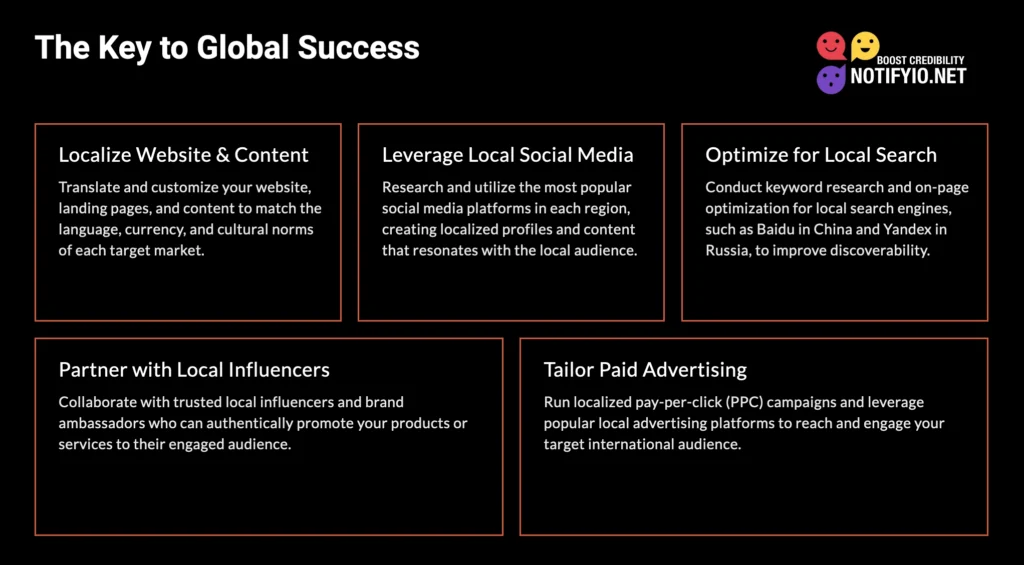
Key Tips
🌐 Localize for Success: Translate and adapt your website, content, social media, and marketing materials to resonate with local languages, cultural norms, and preferences in each target market.
💻 Optimize for Local Search: Conduct thorough keyword research, create localized website versions, and optimize on-page elements for local search engines to improve visibility and discoverability.
👥 Leverage Local Influencers: Partner with influential local personalities, bloggers, or brand ambassadors who can authentically promote your brand and connect with your target audience.
📈 Diversify Marketing Channels: Utilize a mix of organic (SEO, content, social media) and paid (PPC, display ads, affiliate marketing) tactics tailored to each market’s preferences and platform usage.
📊 Measure, Analyze, Refine: Implement robust analytics, continuously monitor performance metrics, and iteratively refine your strategies based on data-driven insights and user feedback.
By following these tips, and using a local, agile, and data-driven approach, you can navigate the complexities of global digital marketing well. And, you can maximize your global reach.
| Key Benefit | Description |
|---|---|
| Expand Market Reach | Tap into new markets and audiences worldwide |
| Increase Brand Visibility | Build brand awareness and recognition across borders |
| Drive International Sales | Generate leads and revenue from global markets |
| Foster Customer Loyalty | Engage and resonate with international customers on a deeper level |
| Stay Competitive | Gain a competitive edge by reaching untapped markets |
“The world is your oyster, but to truly savor its pearls, you must speak the language of your global audience.” – Unknown




Leave a Reply